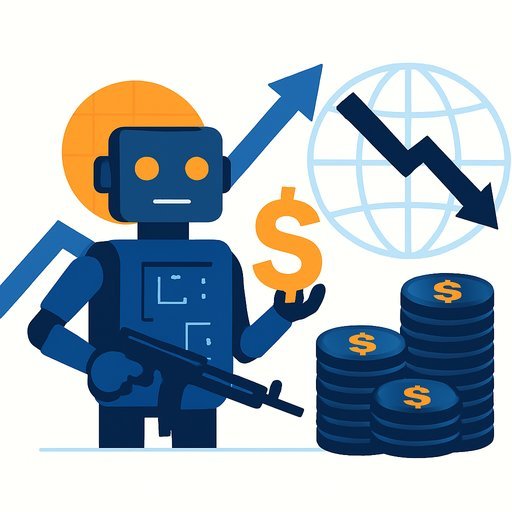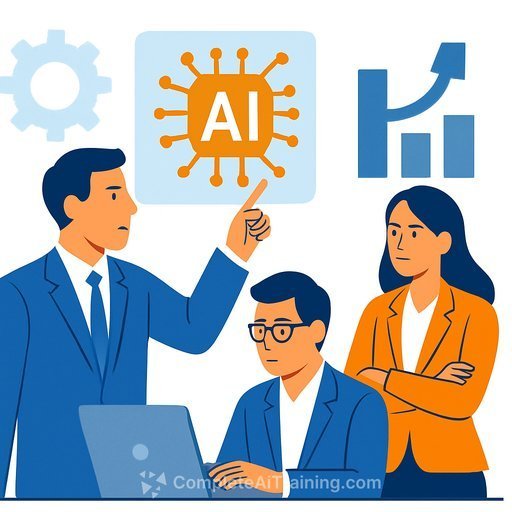AI Strategy: What Happens If the Bubble Pops?
Alphabet's CEO says it plainly: there's "irrationality" in parts of today's AI investment cycle, and no company is immune if a correction hits - including Google. That's a rare admission in a moment of soaring valuations, record spend, and aggressive chip buildouts.
The core message for executives is simple: AI is real, but parts of the market are overheated. Plan for both outcomes - sustained growth and a hard reset - without pausing execution.
Key numbers executives should have on one slide
- Alphabet market cap: ~US$3.5tn (up sharply after doubling in seven months)
- Alphabet UK investment in 2025: £5bn (US$6.58bn) for AI infrastructure and research
- OpenAI-related deals: ~US$1.4tn, with revenues under 0.1% of that figure
- AI electricity use: ~1.5% of global consumption in 2024 (per the IEA)
- Alphabet goal: net zero by 2030, but progress may slow due to energy demands
- Nvidia crossed US$5tn valuation on the back of AI chips; Alphabet is building rival superchips
The bubble risk is real - and familiar
Excitement is rational given AI's potential. Excess is not. We've seen this dynamic before, like the "irrational exuberance" warning during the late 1990s internet cycle.
Here's the point: even category leaders get hit when markets correct. Cash gets tighter, timelines compress, and low-ROI bets are exposed. Build for volatility now, not later.
Reference: 1996 "irrational exuberance" speech
Alphabet's "full stack" is an advantage - not a shield
Alphabet controls chip design, foundational models, data (including YouTube), and research through DeepMind. That integration improves speed, margin capture, and defensibility. It's also why investors believe the firm can push back on OpenAI and Nvidia's momentum.
But a full stack doesn't erase systemic risk. If AI demand slows or capital costs rise, chip capex, data center expansion, and model training budgets all get pressure-tested. Expect ruthless prioritization across product lines in any downturn.
Energy is the constraint most leaders underestimate
AI already accounts for about 1.5% of global electricity use, and demand is climbing. Data center power, cooling, and transmission capacity become gating factors for model scaling and product reliability.
Even Alphabet admits its 2030 net-zero path could slow due to energy needs. Treat power sourcing as a board-level topic, not an ops afterthought.
International Energy Agency: Data centres and AI electricity demand
Jobs: adapt or get sidelined
The leadership view is clear: AI will shift roles; the people who learn and apply the tools will win. That goes for engineers, analysts, operators, and even frontline managers.
Move your teams from theory to reps. Set tool standards, workflows, and KPIs tied to time saved, output quality, and risk controls.
Your 12-month agenda
- Scenario plan for a correction: Create A/B/C cases for AI demand, funding costs, and chip availability. Pre-wire cost takeouts and pivot plans now.
- Capex discipline: Tie model training and chip orders to line-of-sight revenue or unit economics, not vanity metrics. Kill "science projects" fast.
- Energy strategy: Secure PPAs where possible, map local grid constraints, and model power costs into product pricing. Treat power as a strategic input.
- Chip strategy (build/buy/ally): Balance Nvidia, custom silicon, and cloud credits. Avoid single-vendor lock-in that dictates your roadmap.
- Data advantage: Prioritize proprietary data acquisition and rights. Build governance that accelerates safe use while reducing legal exposure.
- Risk and compliance: Stand up model evaluations, audit trails, and content provenance. Assume regulatory scrutiny will rise with spend.
- Talent and training: Mandate AI fluency targets by function. Reward adoption with real incentives; measure output, not attendance.
Signals to watch
- GPU lead times and pricing trends
- Data center permitting and power queue delays
- User retention and unit economics for AI products (not just signups)
- Cloud cost per token or per inference improvements vs. price cuts
- Regulatory movement on AI safety, copyright, energy, and consumer protection
Why the UK expansion matters
Alphabet's £5bn bet in the UK signals deeper commitment to research, training capacity, and talent pools outside the US. Expect model training and advanced research to expand there over time.
For multinationals, that's a cue: build multi-country talent and compute footprints to spread risk, tap incentives, and access power where it's available.
Bottom line for CEOs
AI will create real value. Parts of the market are overheated. Both truths can coexist. Your job is to sequence bets, secure power and chips, and build capability without assuming cheap capital forever.
If the bubble pops, strong operators with disciplined portfolios will gain share. If it doesn't, those same operators will scale faster - without cleaning up a mess.
Practical resources
Your membership also unlocks:






